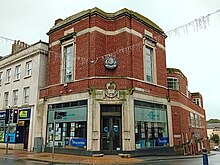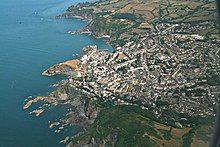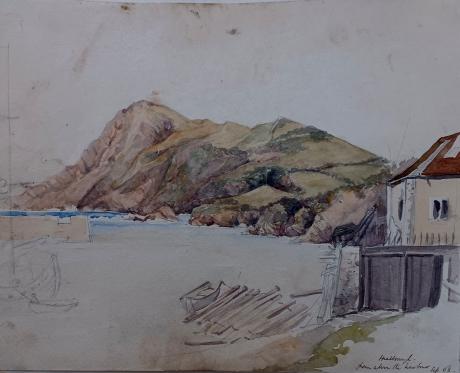inscribed and dated "Hele Bay from Ilfracombe Harbour Sept 1863" and signed with initials "LWT"
Tom and Laura Taylor and thence by descent
Ilfracombe is a seaside resort and civil parish on the North Devon coast, England, with a small harbour surrounded by cliffs.
The parish stretches along the coast from the 'Coastguard Cottages' in Hele Bay toward the east and 4 miles (6 km) along the Torrs to Lee Bay toward the west. The resort is hilly and the highest point within the parish boundary is 'Hore Down Gate', 2 miles (3 km) inland and 860 feet (270 m) above sea level.
The landmark of Hillsborough Hill dominates the harbour and the site of an Iron Age fortified settlement. In the built environment, the architectural-award-winning Landmark Theatre has a distinctive double-conical design. The 13th century parish church, Holy Trinity, and the St Nicholas's Chapel (a lighthouse) on Lantern Hill, have been joined by Damien Hirst's statue of Verity as points of interest.
Main article: History of Ilfracombe
Ilfracombe has been settled since the Iron Age, when the Dumnonii (the Roman name for the inhabitants of the South-West) established a hill fort on the dominant hill, Hillsborough (formerly Hele's Barrow). The origin of the town's name has two possible sources. The first is that it is a derivative of the Anglo-Saxon Alfreinscoma - by which name it was noted in the Liber Exoniensis of 1086. The translation of this name (from Walter William Skeat of the department of Anglo Saxon at Cambridge University) means the "Valley of the sons of Alfred". The second origin is that the name Ilfracombe was derived from Norse illf (bad), Anglo-Saxon yfel (evil ford) and Anglo-Saxon cumb (valley) perhaps from a Celtic source (compare Welsh cwm), thus 'The valley with the bad ford'.
The manor house at Chambercombe in east Ilfracombe was recorded in the 1086 Domesday Book as being built by a Norman knight Champernon (from Chambernon in France) who landed with William of Normandy. It is also said to be haunted.
Ilfracombe comprised two distinct communities; a farming community around the parish church called Holy Trinity, parts of which date from the 12th century, and a fishing community around the natural harbour formed between Capstone, Compass and Lantern Torrs. It is recorded that the lands by the church were part of the estate owned by Champernowne family, while those by the harbour belonged to the Bouchier family: Earls of Bath.

Because of the natural layout of the harbour, Ilfracombe became a significant safe port (registered port of refuge) on the Bristol Channel. It also had trade routes between Kinsale and Tenby, which made the port stronger. In 1208 it was listed as having provided King John with ships and men to invade Ireland; in 1247 it supplied a ship to the fleet that was sent to conquer the Western Isles of Scotland; 6 ships, with 79 men were sent to support the siege of Calais. Ilfracombe was the last disembarkation point for two large forces sent to subdue the Irish. The building which sits on Lantern Hill by the harbour, known as St Nicholas's Chapel (built 1361) is reputed to be the oldest working lighthouse in the UK; a light/beacon has been there for over 650 years.
The town was also home to the Bowen family. James Bowen was sailing master of HMS Queen Charlotte, the flagship of Richard, Earl Howe at the 1794 "Glorious First of June" battle. James Bowen was commissioned by Howe for his leadership in the battle. He rose through the levels - commander of HMS Argo, Dreadnought, and in Georgian England titled "defender of Madeira", led the fleet which rescued the British Army at Corunna in the Peninsular War. For his skill in saving the Peninsula army from Napoleon's forces, he was presented to a joint meeting of the Upper and Lower Houses of Parliament to receive the rare honour of record of "grateful thanks of the nation". He retired as a Rear Admiral and Commissioner of the Royal Navy. Captain Richard Bowen (1761–97) James Bowen's younger brother, a commander on HMS Terpsichore, served under Lord Nelson and was killed at the Battle of Santa Cruz de Tenerife (1797). John Bowen (1780–1827), son of Admiral James Bowen, was a naval officer and colonial administrator. He founded the first settlement of Tasmania at Risdon Cove in 1803 - the settlement that later became known as Hobart. Captain John Bowen married Queen Charlotte's niece.
Lieutenant A E Down was initially posted to Ilfracombe to lead a protection ship for HM Customs and Excise. He married a local girl and rose through the officers’ ranks to retire as Vice Admiral. His son joined the navy aged 14 (his first navy kit is on display at National Maritime Museum, Greenwich). In 1802 James Meek married Down's daughter and settled in the town; James Meek was appointed the Comptroller of Victuals to the Royal Navy in 1832. He was knighted and died in Ilfracombe in 1852. (Gentlemen's Gazette)
There was a wooden fortress overlooking the harbour; of this nothing remains except contemporary records and the area designated Castle Hill off Portland Street/Montepellier Terrace.

The novelist Frances Burney stayed in Ilfracombe in 1817. Her diary entries (2 July – 5 October) record early 19th-century life in Ilfracombe: a captured Spanish ship; two ships in distress in a storm; the visit of Thomas Bowdler; and her lucky escape after being cut off by the tide. A few years later in the 1820s, a set of four tunnels were hand-carved by Welsh miners to permit access to the beaches by horse-drawn carriage as well as on foot. Previously access was gained by climbing the cliffs, rounding the point by boat, swimming or at the lowest tides clambering around the rocks of the point. These tunnels led to a pair of tidal pools, which in accordance with Victorian morals, were used for segregated male and female bathing. Whereas women were constrained to a strict dress code covering up the whole body, men generally swam naked. The tunnels are still viewable and are signposted as Tunnels Beaches.[citation needed]

In 1856, writer Mary Ann Evans (pen-name George Eliot) accompanied George Henry Lewes to Ilfracombe to gather materials for his work Seaside Studies published in 1858. In more recent times, actor Peter Sellers lived in the town when his parents managed the Gaiety Theatre; he first stepped on the stage there and reputedly played the drums. Another actor, Terry Thomas visited the town frequently to stay with his sister, and in the same period, Joan Collins and Jackie Collins were schooled here and boarded in the town. In the last two decades, the town has been home to many artists including locally Damien Hirst, and George Shaw a runner up for the Turner Prize. There is an annual art festival when local artists open their homes for visitors to see their work and 7 to 10 permanent art galleries. The town's first lifeboat was bought in 1828 but a permanent service was not available until the Royal National Lifeboat Institution built a lifeboat station at the bottom of Lantern Hill near the pier in 1866. The present station at Broad Street dates from 1996.

In 1911, the Irish nationalist Anna Catherine Parnell (sister of Charles Stewart Parnell) drowned at Ilfracombe and is buried in the churchyard at Holy Trinity.
Alice Frances Louisa Phillips (b. 26 January 1891 at 85 High Street, Ilfracombe) and her father Escott Robert Phillips (b. 1869 Cardiff) held 2nd class ticket No. 2 on the Titanic, and set sail from Southampton on 10 April 1912 heading for New Brighton, Pennsylvania. Alice was rescued in boat 12, but her father was lost in the disaster.

There are three tiers of local government covering Ilfracombe, at parish (town), district and county level: Ilfracombe Town Council, North Devon Council (based in Barnstaple) and Devon County Council (based in Exeter). Ilfracombe Town Council is based at the Ilfracombe Centre at 44 High Street, which also serves as an area office for North Devon Council.

Ilfracombe was an ancient parish. It was also an ancient borough in the middle ages, but its borough status lapsed and it was subsequently run by its parish vestry, in the same way as most rural areas. Urban forms of local government were re-established in 1851 when a local board was created for the parish. The local board built a town hall at 20 High Street to serve as its headquarters, which was formally opened in 1863.
Local boards were reconstituted as urban district councils in 1894. Ilfracombe Urban District Council was based at the town hall until 1931, when it converted the west wing of the Ilfracombe Hotel on Wilder Road to become its offices and meeting place and sold the town hall. The urban district of Ilfracombe was abolished in 1974 under the Local Government Act 1972, with the area merging with neighbouring districts to become the new North Devon district. A successor parish was created covering the former urban district, with its council taking the name Ilfracombe Town Council. In 1997 the town council established a new headquarters at 44 High Street, which had been built in 1935 as the offices of the Ilfracombe Gas Company, naming it the Ilfracombe Centre.
The town lies within the Parliamentary constituency of North Devon. It had Liberal Democrat representation from 1992 to 2015 with MP Nick Harvey.[25] Since 2015 it has been a Conservative seat, first represented by Peter Heaton-Jones from 2015 to 2019, and since 2019 by Selaine Saxby.
The town is also twinned with Herxheim in Germany and Ifs in France.

Ilfracombe overlies slates formed from sedimentary rock that underwent geological stress (creating faults and folds), towards the end of the Carboniferous Period, around 300 million years ago. These are known as the Ilfracombe slates. Ilfracombe lies within the North Devon Areas of Outstanding Natural Beauty which is renowned for its dramatic coastal cliffs and landscape. Hillsborough, lying close to the town centre is a local nature reserve, and around the town are many other havens for wildlife, notable including the Cairn. The coast itself is part of the North Devon Voluntary Marine Conservation area because of its diverse and rare species.

During the boom times of tourism in the 1950s, there was not a large enough local workforce to serve the needs of the tourism industry during the summer months. Many local businesses advertised in Northern cities such Manchester and Liverpool to alleviate this problem. This 'inward migration' caused social problems and friction between these people and those with a long history of residence. At its peak over 10,000 holidaymakers used the railway each Saturday during peak season, and passenger ferries brought still more. When the tourism market faltered with the arrival of cheap foreign package holidays in the 1960s, and the closure of the railway, unemployment levels rose. In 2001, Ilfracombe Central Ward was designated the most deprived super output area in Devon.[citation needed]
These problems are now being addressed by the implementation of local government schemes such as the Mystart (formerly Sure Start) project to help support families with young children, and, since 2004, the Neighbourhood Management Transform programme. Both of these were the first such government-sponsored social development schemes covering rural areas in England. Better policing, the use of neighbourhood wardens and CCTV have led to a reduction in crime rates recorded by the police on the police and crime website[citation needed] to levels closer to the North Devon average (a fraction of those nationally).
More recently, a 2009 Mosaic study found that all areas of the town are largely populated with close-knit manufacturing town communities, while the surrounding parishes are predominantly populated by people living far from urbanisation. The study also found that south of the town centre is a large contingent of upwardly mobile families living in homes bought from social landlords, while in the south-west of the town, many low-income families live in estate-based social housing.
Ilfracombe has a wide variety of architectural styles dating from the 13th Century to 21st Century. The town has ancient streets leading to the harbour; on higher ground there are Georgian and Regency period terraces and mansions. The period from 1830 to 1900 was a time of great development and has been the subject of several books by J Bates the architecture of Ilfracombe which gives the town a Victorian flavour visible in many buildings. The latest style of architecture can be seen in the award-winning design of the Landmark Theatre.

Ilfracombe has Christian churches of various denominations. The main Anglican church is the parish church, Holy Trinity, which is the mother church to St Peter's on Highfield Road. Several other churches identify themselves as Evangelical, but differ in denominational background. These include: St Philip and St James Church whose background is Anglican; three free churches - Brookdale Evangelical Church and Ilfracombe Christian Fellowship Church, of which the latter is the more charismatic and Ilfracombe Baptist Church of the Baptist tradition on the High Street. There is also the Roman Catholic Our Lady Star of the Sea Church in Runnacleave Road, the Methodist/United Reformed Emmanuel Church on Wilder Road, and the Salvation Army Corps church on Torrs Park, by Bath Place. There is a Jehovah's Witness meeting place in Victoria Road.
Since at least the mid-17th century a light has been displayed from the 14th-century chapel atop Lantern Hill, to guide ships entering the harbour. The light remains operational, and is said to be Britain's oldest lighthouse. The current lantern was installed by Trinity House in 1819; the date is shown on a fish-shaped weather vane. The light was owned and overseen by the Lord of the Manor of Ilfracombe; in the mid-19th century it was gas-powered (it used three gas burners with silvered reflectors) and displayed a fixed red light.
The light is presently operated by the harbour authority and the Grade I listed building is owned by the North Devon Council. Regular worship in the chapel ceased at the Reformation, and for a time the building served as a cottage for lighthouse keepers before falling into some dilapidation. It was restored in 1962, however, by the local Rotary Club, under whose auspices the chapel is open to visitors in the summer months.
Laura Wilson Barker (6 March 1819 – 22 May 1905), was a composer, performer and artist, sometimes also referred to as Laura Barker, Laura W Taylor or "Mrs Tom Taylor".
She was born in Thirkleby, North Yorkshire, third daughter of a clergyman, the Rev. Thomas Barker. She studied privately with Cipriani Potter and became an accomplished pianist and violinist. As a young girl Barker performed with both Louis Spohr and Paganini. She began composing in the mid-1830s - her Seven Romances for voice and guitar were published in 1837. From around 1843 until 1855 she taught music at York School for the Blind. During this period some of her compositions - including a symphony in manuscript, on 19 April 1845 - were performed at York Choral Society concerts.
On 19 June 1855 she married the English dramatist, critic, biographer, public servant, and editor of Punch magazine Tom Taylor. Barker contributed music to at least one of her husband's plays, an overture and entr'acte to Joan of Arc (1871), and provided harmonisations as an appendix to his translation of Ballads and Songs of Brittany (1865).
Her other works include the cantata Enone (1850), the violin sonata A Country Walk (1860), theatre music for As You Like It, (April 1880), Songs of Youth (1884), string quartets, madrigals and solo songs. Her choral setting of Keats's A Prophecy, composed in 1850, was performed for the first time 49 years later at the Hovingham Festival in 1899. The composer was present.
Several of Barker's paintings hang at Smallhythe Place in Kent, Ellen Terry's house.
Barker lived with her husband and family at 84 Lavender Sweep, Battersea. There were two children: the artist John Wycliffe Taylor (1859–1925), and Laura Lucy Arnold Taylor (1863–1940). The Sunday musical soirees at the house attracted many well-known attendees, including Lewis Carroll, Charles Dickens, Henry Irving, Charles Reade, Alfred Tennyson, Ellen Terry and William Makepeace Thackeray.
Tom Taylor died suddenly at his home in 1880 at the age of 62. After his death, his widow retired to Porch House, Coleshill in Buckinghamshire, where she died on 22 May 1905, aged 86.

